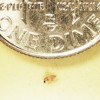Abstract
Biting midges can be a nuisance to campers, fishermen, hunters, hikers, gardeners, and others who spend time outdoors during early morning and evenings, and even during the daytime on cloudy days when winds are calm. They will readily bite humans; the bites are irritating, painful, and can cause long-lasting painful lesions for some people. A common observation upon experiencing a bite from this insect is that something is biting, but the person suffering cannot see what it is. This 4-page fact sheet was written by C. Roxanne Connelly and published by the UF Department of Entomology and Nematology, April 2013.
References
Blanton FS, Wirth WW. 1979. The sand flies (Culicoides) of Florida (Diptera: Ceratopogonidae). Arthropods of Florida and Neighboring Land Areas; Volume 10. Florida Department of Agriculture and Consumer Services. Gainesville, FL. 204 pp.
Day, JF, Duxbury, CG, Glasscock, S and Paganessi, JE. 2001. Removal trapping for the control of coastal biting midge populations. Technical Bulletin of the Florida Mosquito Control Association. 4th Workshop on Salt Marsh Management and Research. Florida Mosquito Control Association, Ft. Myers, FL. 3: 15-16.
Eldridge, BF and Edman, JD, Eds. 2000. Medical Entomology: A Textbook on Public Health and Veterinary Problems Biting midges, no-see-ums Culicoides spp. (Insecta: Diptera: Ceratopogonidae) Caused by Arthropods. Kluwer Academic Publishers, Dordrecht, The Netherlands.
Foote RH, Pratt HD. 1954. The Culicoides of the eastern United States (Diptera, Heleidae). Public Health Monograph No. 18. Publication No. 296. U. S. Department of Health, Education and Welfare, Public Health Service. 53 pp.
Holbrook FR. 1996. Biting midges and the agents they transmit. In Beaty BJ, Marquardt WC (Eds), The Biology of Disease Vectors. University Press of Colorado, Niwot, CO. p. 110-116.
Mullen G. Biting midges (Ceratopogonidae). In Mullen G, Durden L (Eds). 2002. Medical and Veterinary Entomology. Elsevier Science, San Diego, CA. p. 163-183. https://doi.org/10.1016/B978-012510451-7/50012-8
Rutledge CR, Day JF. (2002). Mosquito Repellents. EDIS. University of Florida/IFAS. http://edis.ifas.ufl.edu/IN419 (11 May 2005).
Unless otherwise specified, articles published in the EDIS journal after January 1, 2024 are licensed under a Creative Commons Attribution-NonCommercial-NoDerivs 4.0 International (CC BY-NC-ND 4.0) license.

